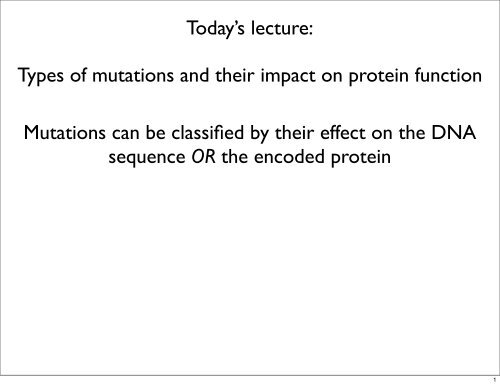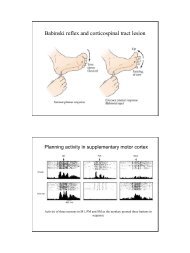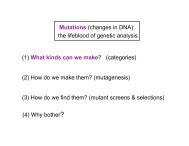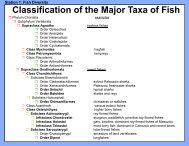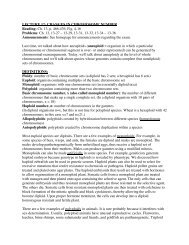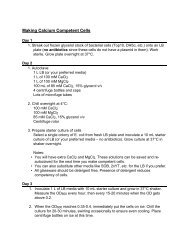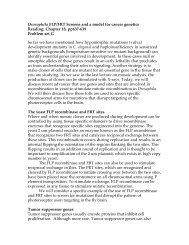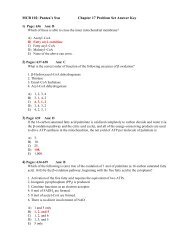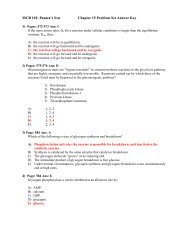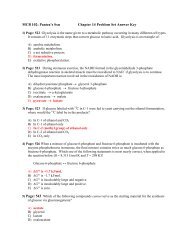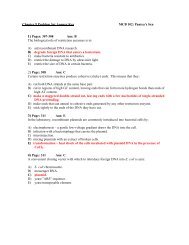Types of mutations and their impact on protein function Today's ...
Types of mutations and their impact on protein function Today's ...
Types of mutations and their impact on protein function Today's ...
Create successful ePaper yourself
Turn your PDF publications into a flip-book with our unique Google optimized e-Paper software.
Today’s lecture:<br />
<str<strong>on</strong>g>Types</str<strong>on</strong>g> <str<strong>on</strong>g>of</str<strong>on</strong>g> <str<strong>on</strong>g>mutati<strong>on</strong>s</str<strong>on</strong>g> <str<strong>on</strong>g>and</str<strong>on</strong>g> <str<strong>on</strong>g>their</str<strong>on</strong>g> <str<strong>on</strong>g>impact</str<strong>on</strong>g> <strong>on</strong> <strong>protein</strong> functi<strong>on</strong><br />
Mutati<strong>on</strong>s can be classified by <str<strong>on</strong>g>their</str<strong>on</strong>g> effect <strong>on</strong> the DNA<br />
sequence OR the encoded <strong>protein</strong><br />
1
From my Lecture 4 (10/1):<br />
Classificati<strong>on</strong> <str<strong>on</strong>g>of</str<strong>on</strong>g> <str<strong>on</strong>g>mutati<strong>on</strong>s</str<strong>on</strong>g> by <str<strong>on</strong>g>their</str<strong>on</strong>g><br />
effects <strong>on</strong> the DNA molecule<br />
• Substituti<strong>on</strong>: base is replaced by <strong>on</strong>e <str<strong>on</strong>g>of</str<strong>on</strong>g> the other<br />
three bases<br />
• Deleti<strong>on</strong>: block <str<strong>on</strong>g>of</str<strong>on</strong>g> <strong>on</strong>e or more DNA pairs is lost<br />
• Inserti<strong>on</strong>: block <str<strong>on</strong>g>of</str<strong>on</strong>g> <strong>on</strong>e or more DNA pairs is added<br />
• Inversi<strong>on</strong>: 180˚ rotati<strong>on</strong> <str<strong>on</strong>g>of</str<strong>on</strong>g> piece <str<strong>on</strong>g>of</str<strong>on</strong>g> DNA<br />
• Reciprocal translocati<strong>on</strong>: parts <str<strong>on</strong>g>of</str<strong>on</strong>g> n<strong>on</strong>homologous<br />
chromosomes change places<br />
• Chromosomal rearrangements: affect many genes at<br />
<strong>on</strong>e time<br />
2
The triplet nature <str<strong>on</strong>g>of</str<strong>on</strong>g> the genetic code means that base changes<br />
within coding sequence can have several different outcomes.<br />
Universal genetic code<br />
I am not going to discuss the experiments that led to the deciphering<br />
<str<strong>on</strong>g>of</str<strong>on</strong>g> the genetic code. If you are interested, they are described in Chapter 8<br />
3
Note:<br />
these are all<br />
substituti<strong>on</strong>s<br />
This <strong>on</strong>e is an<br />
inserti<strong>on</strong><br />
4
Missense mutati<strong>on</strong>: changes an amino acid to another amino<br />
acid. This may or may not affect <strong>protein</strong> functi<strong>on</strong>, depending <strong>on</strong><br />
whether the change is “c<strong>on</strong>servative” or “n<strong>on</strong>c<strong>on</strong>servative,” <str<strong>on</strong>g>and</str<strong>on</strong>g><br />
what the amino acid actually does.<br />
N<strong>on</strong>sense mutati<strong>on</strong>: changes an amino acid to a STOP cod<strong>on</strong>,<br />
resulting in premature terminati<strong>on</strong> <str<strong>on</strong>g>of</str<strong>on</strong>g> translati<strong>on</strong>.<br />
“Silent” mutati<strong>on</strong>: does not change an amino acid, but in some<br />
cases can still have a phenotypic effect, e.g., by speeding up or<br />
slowing down <strong>protein</strong> synthesis, or by affecting splicing.<br />
Frameshift mutati<strong>on</strong>: Deleti<strong>on</strong> or inserti<strong>on</strong> <str<strong>on</strong>g>of</str<strong>on</strong>g> a number <str<strong>on</strong>g>of</str<strong>on</strong>g><br />
bases that is not a multiple <str<strong>on</strong>g>of</str<strong>on</strong>g> 3. Usually introduces premature STOP<br />
cod<strong>on</strong>s in additi<strong>on</strong> to lots <str<strong>on</strong>g>of</str<strong>on</strong>g> amino acid changes.<br />
5
Mutati<strong>on</strong>s outside the coding sequence can also <str<strong>on</strong>g>impact</str<strong>on</strong>g><br />
gene expressi<strong>on</strong><br />
Promoter or enhancer* sequences<br />
Terminati<strong>on</strong> signals<br />
Splice d<strong>on</strong>or <str<strong>on</strong>g>and</str<strong>on</strong>g> acceptor sites<br />
Ribosome binding sites<br />
*Enhancers are regulatory elements that specify where <str<strong>on</strong>g>and</str<strong>on</strong>g> when<br />
particular genes are expressed<br />
6
Not all <str<strong>on</strong>g>of</str<strong>on</strong>g> the mutable informati<strong>on</strong> in a gene is “coding.”<br />
A. Genes include informati<strong>on</strong> that tells the RNA<br />
polymerase where to start <str<strong>on</strong>g>and</str<strong>on</strong>g> stop<br />
(transcripti<strong>on</strong> initiati<strong>on</strong> <str<strong>on</strong>g>and</str<strong>on</strong>g> terminati<strong>on</strong> signals).<br />
7
Initiati<strong>on</strong> <str<strong>on</strong>g>of</str<strong>on</strong>g> transcripti<strong>on</strong> (bacteria)<br />
Initiati<strong>on</strong> is c<strong>on</strong>trolled by short sequence elements called<br />
promoters, just upstream (5’) <str<strong>on</strong>g>of</str<strong>on</strong>g> the gene<br />
8
El<strong>on</strong>gati<strong>on</strong><br />
9
Terminati<strong>on</strong> <str<strong>on</strong>g>of</str<strong>on</strong>g> transcripti<strong>on</strong> (bacteria)<br />
10
Not all <str<strong>on</strong>g>of</str<strong>on</strong>g> the mutable informati<strong>on</strong> in a gene is “coding.”<br />
A. Genes include informati<strong>on</strong> that tells the<br />
RNA polymerase where to start <str<strong>on</strong>g>and</str<strong>on</strong>g> stop<br />
(transcripti<strong>on</strong> initiati<strong>on</strong> <str<strong>on</strong>g>and</str<strong>on</strong>g> terminati<strong>on</strong> signals).<br />
B. In eukaryotes, there is additi<strong>on</strong>al informati<strong>on</strong> that<br />
tells the splicing machinery where to cut <str<strong>on</strong>g>and</str<strong>on</strong>g> paste.<br />
11
In eukaryotes, RNA synthesis <str<strong>on</strong>g>and</str<strong>on</strong>g> processing<br />
5’ “capping”<br />
are more complex<br />
3’ end polyadenylati<strong>on</strong><br />
(additi<strong>on</strong> <str<strong>on</strong>g>of</str<strong>on</strong>g> poly-A tail)<br />
12
Most eukaryotic genes c<strong>on</strong>tain intr<strong>on</strong>s, which are<br />
removed by a process called splicing<br />
splice d<strong>on</strong>or<br />
sequence<br />
splice acceptor<br />
sequence<br />
13
Most eukaryotic genes c<strong>on</strong>tain intr<strong>on</strong>s, which are<br />
removed by a process called splicing<br />
The “mature” mRNA has an added 5’ cap <str<strong>on</strong>g>and</str<strong>on</strong>g> poly-A tail,<br />
<str<strong>on</strong>g>and</str<strong>on</strong>g> all <str<strong>on</strong>g>of</str<strong>on</strong>g> the intr<strong>on</strong>s removed. It can be MUCH smaller<br />
than the “primary transcript.”<br />
note: not to scale!<br />
14
Sometimes there are multiple potential<br />
transcripti<strong>on</strong>al start <str<strong>on</strong>g>and</str<strong>on</strong>g>/or splice sites<br />
15
Mutati<strong>on</strong>s outside the coding sequence can also <str<strong>on</strong>g>impact</str<strong>on</strong>g><br />
gene expressi<strong>on</strong><br />
Promoter or enhancer* sequences<br />
Terminati<strong>on</strong> signals<br />
Splice d<strong>on</strong>or <str<strong>on</strong>g>and</str<strong>on</strong>g> acceptor sites<br />
Ribosome binding sites<br />
*Enhancers are regulatory elements that specify where <str<strong>on</strong>g>and</str<strong>on</strong>g> when<br />
particular genes are expressed<br />
16
Mutati<strong>on</strong>s are also classified by <str<strong>on</strong>g>their</str<strong>on</strong>g> <str<strong>on</strong>g>impact</str<strong>on</strong>g><br />
<strong>on</strong> <strong>protein</strong> functi<strong>on</strong>:<br />
Loss <str<strong>on</strong>g>of</str<strong>on</strong>g> functi<strong>on</strong><br />
Complete loss <str<strong>on</strong>g>of</str<strong>on</strong>g> the <strong>protein</strong>:<br />
null, loss-<str<strong>on</strong>g>of</str<strong>on</strong>g>-functi<strong>on</strong>, amorph<br />
Reducti<strong>on</strong> <str<strong>on</strong>g>of</str<strong>on</strong>g> <strong>protein</strong>’s ability to work:<br />
hypomorph, reducti<strong>on</strong>-<str<strong>on</strong>g>of</str<strong>on</strong>g>-functi<strong>on</strong><br />
Gain <str<strong>on</strong>g>of</str<strong>on</strong>g> functi<strong>on</strong><br />
Increase in the <strong>protein</strong>’s functi<strong>on</strong>:<br />
hypermorph, gain-<str<strong>on</strong>g>of</str<strong>on</strong>g>-functi<strong>on</strong><br />
A <strong>protein</strong> that interferes with the wild-type <strong>protein</strong>’s functi<strong>on</strong>:<br />
antimorph, dominant negative<br />
Acquisiti<strong>on</strong> <str<strong>on</strong>g>of</str<strong>on</strong>g> a new functi<strong>on</strong> (or ectopic expressi<strong>on</strong> <str<strong>on</strong>g>of</str<strong>on</strong>g> the functi<strong>on</strong>):<br />
neomorph, dominant gain-<str<strong>on</strong>g>of</str<strong>on</strong>g>-functi<strong>on</strong><br />
These terms are frequently misused, <str<strong>on</strong>g>and</str<strong>on</strong>g> also c<strong>on</strong>text-dependent<br />
17
The distincti<strong>on</strong> between loss-<str<strong>on</strong>g>of</str<strong>on</strong>g>-functi<strong>on</strong><br />
<str<strong>on</strong>g>and</str<strong>on</strong>g> gain-<str<strong>on</strong>g>of</str<strong>on</strong>g>-functi<strong>on</strong> is not always super-clear.<br />
Loss-<str<strong>on</strong>g>of</str<strong>on</strong>g>-functi<strong>on</strong> usually means that less <str<strong>on</strong>g>of</str<strong>on</strong>g> a <strong>protein</strong> is made or that some<br />
functi<strong>on</strong> <str<strong>on</strong>g>of</str<strong>on</strong>g> the <strong>protein</strong> has been compromised.<br />
Loss-<str<strong>on</strong>g>of</str<strong>on</strong>g>-functi<strong>on</strong> <str<strong>on</strong>g>mutati<strong>on</strong>s</str<strong>on</strong>g> are usually recessive, since in most cases, a<br />
single “good” copy <str<strong>on</strong>g>of</str<strong>on</strong>g> the gene will suffice.<br />
2 comm<strong>on</strong> types <str<strong>on</strong>g>of</str<strong>on</strong>g> excepti<strong>on</strong>s:<br />
“Haploinsufficiency”:<br />
One copy is not enough<br />
“Dominant negative” or “antimorphic” <str<strong>on</strong>g>mutati<strong>on</strong>s</str<strong>on</strong>g>:<br />
The defective gene interferes with the functi<strong>on</strong> <str<strong>on</strong>g>of</str<strong>on</strong>g> the wild-type copy.<br />
This is comm<strong>on</strong> with <strong>protein</strong>s that form polymeric structures, such as<br />
filaments.<br />
18
Cystic Fibrosis shows the “expected” recessive pattern <str<strong>on</strong>g>of</str<strong>on</strong>g><br />
inheritance for a loss-<str<strong>on</strong>g>of</str<strong>on</strong>g>-functi<strong>on</strong> allele <str<strong>on</strong>g>of</str<strong>on</strong>g> a gene<br />
CFTR = cystic fibrosis transmembrane c<strong>on</strong>ductance regulator,<br />
a salt transporter required for normal<br />
functi<strong>on</strong> <str<strong>on</strong>g>of</str<strong>on</strong>g> the lungs, pancreas, <str<strong>on</strong>g>and</str<strong>on</strong>g> other tissues.<br />
CFTR is a large gene that encodes a large <strong>protein</strong>, making it a<br />
big target for <str<strong>on</strong>g>mutati<strong>on</strong>s</str<strong>on</strong>g><br />
19
Another example <str<strong>on</strong>g>of</str<strong>on</strong>g> a recessive loss-<str<strong>on</strong>g>of</str<strong>on</strong>g> functi<strong>on</strong> allele:<br />
Lactose intolerance is usually the result <str<strong>on</strong>g>of</str<strong>on</strong>g><br />
“reducti<strong>on</strong>-<str<strong>on</strong>g>of</str<strong>on</strong>g>-functi<strong>on</strong>” alleles that<br />
have low expressi<strong>on</strong> <str<strong>on</strong>g>of</str<strong>on</strong>g> the lactase enzyme in adults<br />
disaccharide m<strong>on</strong>osaccharides<br />
Lactose tolerance (also known as persistence) is, historically speaking, the “mutant” form.<br />
Most mammals (including early humans) do not drink milk after infancy, <str<strong>on</strong>g>and</str<strong>on</strong>g> the lactose<br />
gene is usually inactivated (i.e., shut <str<strong>on</strong>g>of</str<strong>on</strong>g>f). Many human populati<strong>on</strong>s, particularly in Europe,<br />
where dairy cows were domesticated, acquired the ability to metabolize lactose<br />
throughout adult life, most likely by mutati<strong>on</strong> <str<strong>on</strong>g>of</str<strong>on</strong>g> regulatory elements in the lactase gene<br />
promoter regi<strong>on</strong>.<br />
This has apparently happened independently am<strong>on</strong>g some east African populati<strong>on</strong>s.<br />
Lactose intolerance is very prevalent am<strong>on</strong>g n<strong>on</strong>-European populati<strong>on</strong>s.<br />
Lactose tolerance is dominant over intolerance, for reas<strong>on</strong>s that should be obvious. In<br />
other words, lactose intolerance shows recessive inheritance.<br />
20
Vincent Schiavelli<br />
1948-2005<br />
Marfan syndrome is caused by <str<strong>on</strong>g>mutati<strong>on</strong>s</str<strong>on</strong>g> that truncate the FBN1 gene, which<br />
encodes Fibrillin-1, a <strong>protein</strong> that forms micr<str<strong>on</strong>g>of</str<strong>on</strong>g>ibrils in the extracellular matrix.<br />
Radial fiber<br />
l<strong>on</strong>gitudinal<br />
secti<strong>on</strong><br />
cross-secti<strong>on</strong><br />
Marfan syndrome is caused by<br />
“dominant negative”<br />
<str<strong>on</strong>g>mutati<strong>on</strong>s</str<strong>on</strong>g><br />
in the FBN1 gene<br />
Fibrillin-1<br />
Fibrillin-1 assembles into l<strong>on</strong>g chains (micr<str<strong>on</strong>g>of</str<strong>on</strong>g>ibrils)<br />
that bundle together to form fibers<br />
Defective Fibrillin-1 <strong>protein</strong>s disrupt the integrity<br />
<str<strong>on</strong>g>of</str<strong>on</strong>g> the chains.<br />
21
Haploinsufficiency:<br />
Familial Hypercholesterolemia (FH; high cholesterol)<br />
can result from having <strong>on</strong>ly <strong>on</strong>e good copy <str<strong>on</strong>g>of</str<strong>on</strong>g> the<br />
LDL uptake from blood<br />
LDL receptor gene<br />
LDL (low density<br />
lipo<strong>protein</strong>) particle<br />
Lots <str<strong>on</strong>g>of</str<strong>on</strong>g> different <str<strong>on</strong>g>mutati<strong>on</strong>s</str<strong>on</strong>g> cause dominant<br />
familial hypercholesterolemia (FH)<br />
by disrupting LDL receptor functi<strong>on</strong><br />
22
“Gain-<str<strong>on</strong>g>of</str<strong>on</strong>g>-functi<strong>on</strong>” <str<strong>on</strong>g>mutati<strong>on</strong>s</str<strong>on</strong>g> are almost always dominant<br />
Antennapedia mutati<strong>on</strong> in Drosophila<br />
23
“Gain-<str<strong>on</strong>g>of</str<strong>on</strong>g>-functi<strong>on</strong>” <str<strong>on</strong>g>mutati<strong>on</strong>s</str<strong>on</strong>g> are almost always dominant<br />
2 pedigrees showing dominant<br />
inheritance <str<strong>on</strong>g>of</str<strong>on</strong>g> pancreatitis<br />
trypsin<br />
Hereditary pancreatitis is caused by a mutati<strong>on</strong> that causes a digestive enzyme,<br />
trypsin, to become aberrantly active inside the pancreas.<br />
Normally, the pancreas is protected because active trypsin will destroy itself<br />
by cutting at R117. This will split the trypsin <str<strong>on</strong>g>and</str<strong>on</strong>g> inactivate it.<br />
In HP, R117 is mutated to H117. This creates a “super-trypsin” that<br />
cannot be inactivated <str<strong>on</strong>g>and</str<strong>on</strong>g> leads to acute pancreatitis.<br />
pancreatic<br />
acinar cell<br />
24
“Gain-<str<strong>on</strong>g>of</str<strong>on</strong>g>-functi<strong>on</strong>” is defined with respect to a specific functi<strong>on</strong><br />
Variati<strong>on</strong>s in the beta globin gene<br />
(HbS alleles) cause sickle cell anemia. The<br />
disease is inherited as a recessive trait,<br />
but the same <str<strong>on</strong>g>mutati<strong>on</strong>s</str<strong>on</strong>g> result in dominant<br />
inheritance <str<strong>on</strong>g>of</str<strong>on</strong>g> resistance to malaria.<br />
sickle-shaped red blood cells<br />
tend to clump together,<br />
restricting oxygen delivery <str<strong>on</strong>g>and</str<strong>on</strong>g><br />
causing more acute symptoms.<br />
Thallasemia <str<strong>on</strong>g>and</str<strong>on</strong>g> G6PD are other recessive genetic diseases for which a<br />
single mutati<strong>on</strong> c<strong>on</strong>fers malaria resistance.<br />
25


